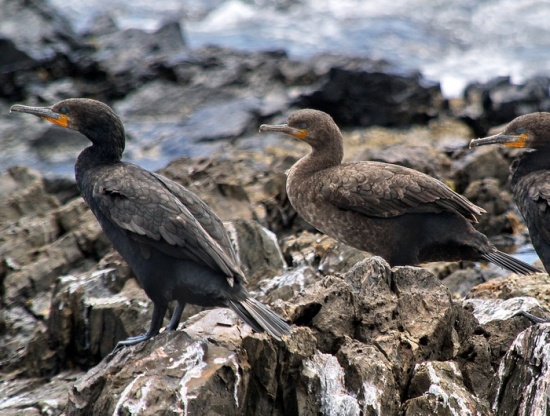m (→Identification) |
(Main picture changed for clearer image. Flight photo. References) |
||
| Line 1: | Line 1: | ||
;[[:Category:Phalacrocorax|Phalacrocorax]] capensis | ;[[:Category:Phalacrocorax|Phalacrocorax]] capensis | ||
| − | [[Image: | + | [[Image:53334700cape corm.jpg|thumb|550px|right|Adult (left) and Juvenile <br />Photo by {{user|CollinBax|CollinBax}}<br />Sea Point, Western Cape, [[South Africa]], January 2007]] |
==Identification== | ==Identification== | ||
| − | Length 61-64 cm, mass 1.0-1.6 kg, males larger than females | + | Length 61-64 cm, mass 1.0-1.6 kg, males larger than females<br /> |
| − | + | '''Breeding Adult''': Glossy blue-black plumage, with white filoplumes on the head, neck and vent. Bill, legs and feet black. The eyes are turquoise, with a greenish eye-ring. The bare skin below the eye and the base of the lower bill is orange, as is the gular pouch.<br /> | |
| − | '''Breeding Adult''': Glossy blue-black plumage, with white filoplumes on the head, neck and vent. Bill, legs and feet black. The eyes are turquoise, with a greenish eye-ring. The bare skin below the eye and the base of the lower bill is orange, as is the gular pouch. | ||
| − | |||
'''Non-breeding Adult''': Generally duller than the breeding adults, without white filoplumes, and with throat and breast mottled brown. | '''Non-breeding Adult''': Generally duller than the breeding adults, without white filoplumes, and with throat and breast mottled brown. | ||
| − | |||
==Distribution== | ==Distribution== | ||
| + | [[Image:CapeCormorants.jpg|thumb|350px|right|Photo by {{user|Bartail|Bartail}}<br />Hermanus Bay, [[South Africa]], August 2009]] | ||
Coast of [[Namibia]] and western and southern coast of [[South Africa]]. | Coast of [[Namibia]] and western and southern coast of [[South Africa]]. | ||
==Taxonomy== | ==Taxonomy== | ||
| − | + | This is a [[Dictionary_M-S#M|monotypic]] species<sup>[[#References|[1]]]</sup>. | |
==Habitat== | ==Habitat== | ||
Marine coast. | Marine coast. | ||
==Status== | ==Status== | ||
| − | Classified as '''Near-threatened''' in the IUCN Red List | + | Classified as '''Near-threatened''' in the IUCN Red List. |
==Behaviour== | ==Behaviour== | ||
| − | Roosts in large flocks, some numbering thousands. Forages up to 80 km offshore, usually in large flocks, often with [[Cape Gannet]]s, gulls and terns. Feeds mainly on pelagic schooling fish. | + | Roosts in large flocks, some numbering thousands. Forages up to 80 km offshore, usually in large flocks, often with [[Cape Gannet]]s, gulls and terns. |
| − | + | ====Diet==== | |
| − | + | Feeds mainly on pelagic schooling fish. | |
| − | + | ====Breeding==== | |
| + | Monogamous, often nesting in large colonies. The nest is a loose pile built with various materials including sticks, feathers, dry seaweed, bones and human debris. One to five eggs are laid, usually September to February. Predators of nestlings include Cape Fur Seal, [[Great White Pelican]], [[Kelp Gull]], [[Sacred Ibis]], and [[White-breasted Cormorant]]. | ||
==References== | ==References== | ||
| − | BirdLife International | + | #{{Ref-Clements6thDec09}}#BirdLife International |
| − | + | #Avibase | |
| − | + | {{ref}} | |
==External Links== | ==External Links== | ||
{{GSearch|Phalacrocorax+capensis}} | {{GSearch|Phalacrocorax+capensis}} | ||
[[Category:Birds]] [[Category:Phalacrocorax]] | [[Category:Birds]] [[Category:Phalacrocorax]] | ||
Revision as of 21:21, 4 October 2010
- Phalacrocorax capensis
Identification
Length 61-64 cm, mass 1.0-1.6 kg, males larger than females
Breeding Adult: Glossy blue-black plumage, with white filoplumes on the head, neck and vent. Bill, legs and feet black. The eyes are turquoise, with a greenish eye-ring. The bare skin below the eye and the base of the lower bill is orange, as is the gular pouch.
Non-breeding Adult: Generally duller than the breeding adults, without white filoplumes, and with throat and breast mottled brown.
Distribution
Coast of Namibia and western and southern coast of South Africa.
Taxonomy
This is a monotypic species[1].
Habitat
Marine coast.
Status
Classified as Near-threatened in the IUCN Red List.
Behaviour
Roosts in large flocks, some numbering thousands. Forages up to 80 km offshore, usually in large flocks, often with Cape Gannets, gulls and terns.
Diet
Feeds mainly on pelagic schooling fish.
Breeding
Monogamous, often nesting in large colonies. The nest is a loose pile built with various materials including sticks, feathers, dry seaweed, bones and human debris. One to five eggs are laid, usually September to February. Predators of nestlings include Cape Fur Seal, Great White Pelican, Kelp Gull, Sacred Ibis, and White-breasted Cormorant.
References
- Clements, JF. 2009. The Clements Checklist of Birds of the World. 6th ed., with updates to December 2009. Ithaca: Cornell Univ. Press. ISBN 978-0801445019.
- BirdLife International
- Avibase
Recommended Citation
- BirdForum Opus contributors. (2024) Cape Cormorant. In: BirdForum, the forum for wild birds and birding. Retrieved 15 May 2024 from https://www.birdforum.net/opus/Cape_Cormorant





